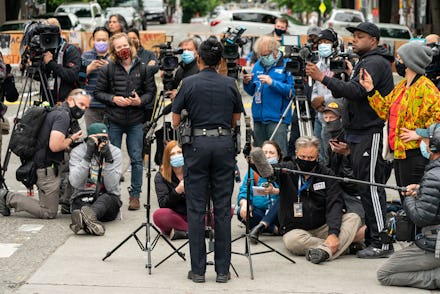Seattle's Capitol Hill Organized Protest is over — for now

After nearly a month of organized protest and occupation, Seattle's leaders ordered that the CHOP — the Capitol Hill Organized Protest — be disbanded. For a few weeks, protesters lived, worked, and socialized in a police-free region in the Capitol Hill neighborhood of the city, which originally came to be known as the Capitol Hill Autonomous Zone (CHAZ). The organizers rebranded as the Capitol Hill Organized Protest, however, to make clear that they weren't seceding from official government but rather a concerted and unique protest effort.
Protesters and the CHOP as a whole gained national attention last month, amid the demonstrations against white supremacy and police violence against Black people. Protests across the country raised calls to defund city police departments, and in Seattle, residents demonstrated what a world without police might look like, with trained social workers and emergency medicine technicians taking on unofficial roles where police might usually step in.
Early Wednesday morning, though, nearly three weeks after its creation, police moved into the CHOP area following orders from Seattle Mayor Jenny Durkan (D) and Seattle's police chief Carmen Best. The city said that the dispersal order from Durkan was a response to growing concerns of violence in the area and complaints from residents and business owners in the neighborhood.
"City departments have more than reasonably accommodated protesters by offerings services and shelter," Durkan wrote in the executive order. "The city has spent weeks on voluntary efforts to urge people to leave the Cal Anderson Park area given the emerging circumstances and recent shootings." On June 20, a 19-year-old was shot and killed in the first shooting in the CHOP area; since then, three more shootings have occurred, and a second teenager has died.
Protesters had occupied several blocks centered around the police department's East Precinct, which officers abandoned on June 8. Shortly after police left the area, Seattle residents and protesters established housing, food tents, and health care stations, and released a list of racial justice demands to be met before they would disperse. As one CHOP protester previously told Mic, the movement was an evolving practice of independence and interdependence, with individuals stepping in where they are needed based on their existing expertise. People were free to share stories, contribute art, and participate in movie screenings, reinforcing the idea of the CHOP as a community space.
City leaders were adamant that they support the Black Lives Matter movement, and that the move to disperse the area was intended to keep the public safe. Best said in a statement, "As I have said, and I will say again, I support peaceful demonstrations, Black Lives Matter, and I too want to help propel this movement toward meaningful change in our community. But enough is enough." She added that the shootings were a major concern. "Two African American men are dead, at a place where they claim to be working for Black Lives Matter," she said. Volunteer CHOP emergency medics had attended to the victims and worked to transport them to local hospitals.
In their initial interactions with protesters, police indiscriminately used tear gas, pepper spray, and force on people, including children. The violence gained national attention, which propelled city leaders to temporarily ban the use of tear gas. Still, videos posted to Twitter the following day showed smoke billowing above the heads of protesters forced to retreat from the site of their demonstration.
By 9:25 a.m. Wednesday, Seattle police reported that officers arrested at least 31 people. "Officers continue to give dispersal orders and are checking Cal Anderson restrooms. Police will be clearing north end of the park soon."
The Seattle Parks and Recreation Department temporarily closed Cal Anderson Park — where the CHOP had established food and medic tents — to "assess damage" and clean the area. The department's statement also made clear that police were not expected to monitor the park area.
Local independent news outlet Converge Media posted a Facebook Live on Wednesday morning that said Seattle police had re-entered the CHOP area. The video shows abandoned camping tents, what's left of the concrete barriers formerly reclaimed by protesters, and rows of police in riot gear blocking access to area. "Bit by bit, what was once known as the CHOP is being dismantled," the reporter said.
Throughout the past month, the CHOP activists and city officials have pushed competing narratives about the intention and consequences of the protest area. On Twitter, police attempted to justify their decision to dress in riot gear, saying that officers were "wearing a highesr level of protective gear ... because individuals associated with the CHOP are known to be armed and dangerous/may be associated with shootings, homicides, robberies, assaults, and other violent crimes."
Protesters, meanwhile, insisted that most everyone has been peaceful, noting that even when conflict did occur, volunteers dealt with contentious situations while trying to maintain justice and autonomy. In the end, it seems this radical experiment in a police-free world is over — for now.